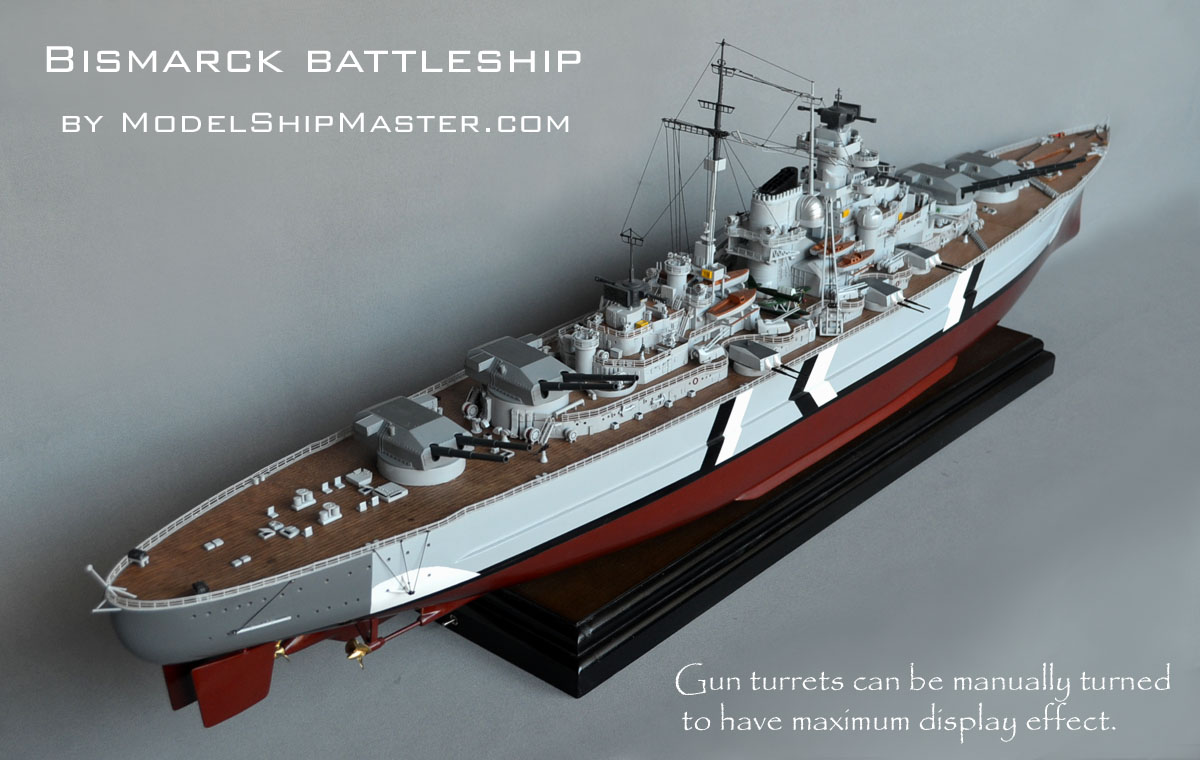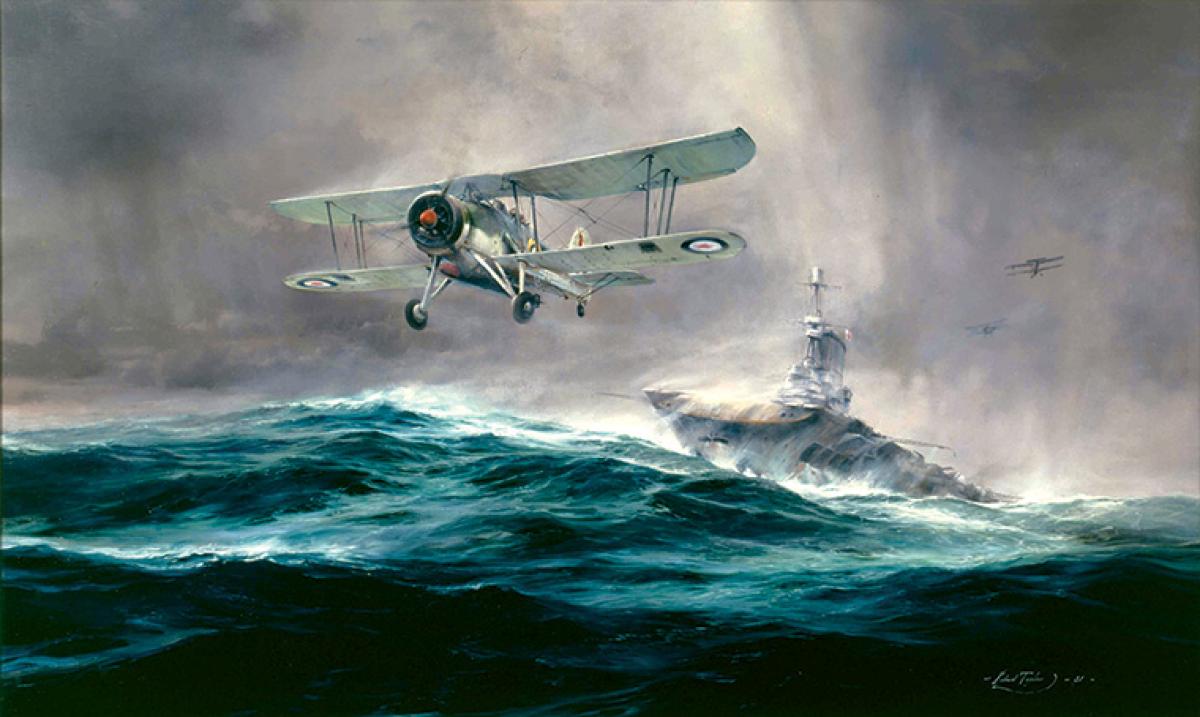Old Navy Bismarck - The Bismarck was the first of two Bismarck-class battleships built for the Kriegsmarine of Nazi Germany. Named Chancellor Otto von Bismarck, the ship was laid down at the Blohm & Voss shipyard in Hamburg in July 1936 and launched in February 1939. Work was completed in August 1940, when she entered service with the German Navy. Bismarck and her cruiser Tirpitz were the largest warships ever built by Germany, and two of the largest built by any European power.
During the eight months of the war, Bismarck carried out only one offensive operation that lasted 8 days in May 1941, called Rheinübung. The ship, along with the heavy cruiser Prinz Eug, breached the Atlantic and attacked Allied shipping from North America to Britain. The two ships were seen several times from Scandinavia, and British naval forces were sent to block their path. In the Battle of Dmark Sound, HMS Hood engaged Prinz Eug, possibly by mistake, while HMS Prince of Wales engaged Bismarck. In close combat, Hood was destroyed by the combined fire of Bismarck and Prinz Eug, which destroyed the Prince of Wales and forced him to retreat. Bismarck suffered enough damage in three hits by the Prince of Wales to force d into a destroyer mission.
Old Navy Bismarck

The destruction of Hood prompted a continuous search by the Navy that included many warships. Two days later, while en route to France for repairs, Bismarck was attacked by five Fairey Swordfish torpedoes from the aircraft carrier HMS Ark Royal; one hit which caused the warship's rudder to fail. In his last battle the next morning, the already crippled Bismarck was escorted by two British battleships and two heavy cruisers, suffering heavy damage and heavy loss of life. The ship was scuttled to avoid being boarded by the British and allowed the ship to be abandoned to minimize further casualties. Most experts agree that the damage from the battle would have caused him to drown.
The Hunt For The Bismarck. Learn About The Historic Hunt For The…
The wreck was discovered in June 1989 by Robert Ballard and since then it has been investigated by several other expeditions.
Bismarck-class battleships were built in the mid-1930s by the German Kriegsmarine as a countermeasure to French naval expansion, particularly the Richelieu-class battleships that France introduced in 1935. They were decommissioned after the signing of the Treaty. In 1935, Bismarck and her sister Tirpitz were within the 35,000 ton (36,000 t) limit set by the Washington Naval Treaty which regulated wartime warship construction. The ships secretly exceeded the number by a large margin, but before all the ships were completed, the international agreement was broken after the withdrawal of Japan in 1937, allowing the signatories to invoke the "escalator clause" which allowed the evacuation of up to 45,000 people. long. tons (46,000 t).
Bismarck displaced 41,700 t (41,000 long tons) when built and 50,300 t (49,500 t) loaded, with an overall length of 251 m (823 ft 6 in), a beam of 36 m (118 ft 1 in) of 9.9 m (32 ft 6 in).
Bismarck was powered by three Blohm & Voss steam turbines and 12 Wagner oil-fired boilers, producing 148,116 shp (110,450 kW), giving a maximum speed of 30.01 knots/h; 34.53 mph) in the speed test. The ship had 16,430 kilometers; 10,210 mi) at 19 knots (35 km/h; 22 mph).
The Royal Navy's 'old Ark'
The Bismarck had three FuMO 23 radar search engines, mounted forward and aft with sights.
The crew was divided into twelve divisions between 180 and 220. The first six divisions were assigned to the ship's weapons, one to four divisions to the main and advanced batteries, and five and six anti-aircraft guns. The Seventh Division consisted of professionals, including cooks and carpenters, and the Eighth Division consisted of equipment maintainers. Radio operators, signal masters and quartermasters were assigned to the Ninth Division. The last three quarters were the staff of the gin room. By the time Bismarck left port, sailors, marines, prizemen and war correspondents had increased the crew to more than 2,200 m.
About 200 people working in the gin room came from the light cruiser Karlsruhe, which was lost during Operation Weserübung, the German invasion of Norway.

This paper was published only once, on April 23, 1941, by the head of the mechanical engineering department, Gerhard Junack.
Old Battleship Hi Res Stock Photography And Images
Bismarck had eight 38 cm (15 in) SK C/34 guns mounted in four twin gun groups: two forward gunners – "Anton" and "Bruno" – and two aft – "Caesar" and " Dora".
The secondary armament consisted of twelve 15 cm (5.9 in) L/55 guns, sixty 10.5 cm (4.1 in) L/65 guns, sixteen 3.7 cm (1.5 in) L/83 and ten and two 2 cm (0.79 in) anti-aircraft guns. Bismarck also carried four Arado Ar 196 aircraft carriers in double decks and two canal-side hangars, equipped with double anti-ship armament.
The main belt of the ship was 320 mm (12.6 in) thick and covered with high and large armor that was 50 mm (2 in) and 100 to 120 mm (3.9–4.7 in) thick. The 38 cm (15 in) turrets were protected by 360 mm (14.2 in) thick faces and 220 mm (8.7 in) thick sides.
Bismarck was ordered under the name Ersatz Hannover ("Hannover replacemt"), replacing the old pre-dreadnought SMS Hannover, under contract "F".
The Royal Navy's Ill Fated Symbol
The contract was awarded to the Blohm & Voss shipyard in Hamburg, where the keel was laid on 1 July 1936 for Helg IX.
The ship was launched on 14 February 1939 and was christened in many ceremonies by Dorothee von Löwfeld, granddaughter of Chancellor Otto von Bismarck, the ship's namesake. Adolf Hitler gave a Christian message.
Refit work followed the launch, during which the original straight stem was replaced with a shaved "Atlantic bow" similar to the Scharnhorst battleships.

What happened in the Baltic Sea. Kapitän zur See Ernst Lindemann took command of the ship on dispatch.
Yamato,bismarck &iowa. (720×1242)
On 15 September 1940, three weeks after being commissioned, Bismarck left Hamburg to begin sea trials in the Bay of Kiel.
Sperrbrecher 13 escorted the ship from Arcona on 28 September to Gothaf for trials in the Gulf of Danzig.
The ship's power plant took a workout; Bismarck made the measured miles and the fastest. After testing the ship's stability and maneuverability, it was found to be faulty. When the sailors tried to steer the ship by simply changing the speed of the propeller, the crew realized that the Bismarck was able to move with great difficulty. Even the propellers that ran with full power in opposite directions, produced only a small amount of power.
Bismarck's main battery guns were first tested at the end of November. These tests showed her to be a stable weapon platform.
Pit Road Pit Road 1/700 Sky Wave Series German Navy Battleship Bismarck (same Type Ship Tirupittsu Possible Production) Plastic Model W192
Trials continued until December; Bismarck returned to Hamburg, arriving on 9 December, to refit and complete the necessary work.
The ship was supposed to return to Kiel on 24 January 1941, but a merchant ship sank in the Kiel River, preventing the use of the waterway. Difficult weather prevented the evacuation of the wreck, and Bismarck was not able to reach Kiel until March.
The delay greatly frustrated Lindemann, who said that "[Bismarck] was detained in Hamburg for five weeks ... so it is inevitable."

While waiting to reach Kiel, Bismarck received Captain Anders Forshell, a Swedish military officer in Berlin. He returned to Swed with a detailed description of the ship, which was later brought down to Britain by pro-British forces in the Swedish army. This information provided the Royal Navy with the first description of the ship, although it lacked key details, including top speed, range of action and displacement.
Swordfish: The 'old' Plane That Help Sink Hitler's Bismarck Battleship
On March 6, Bismarck was ordered to proceed to Kiel. During the voyage, the ship was escorted by several Messerschmitt Bf 109s and two merchant ships, along with an icebreaker. At 08:45 on 8 March, Bismarck moved slowly along the shore of the Kiel Canal; he was released within an hour. The ship arrived in Kiel the next day, where her crew stored weapons, fuel and other supplies and applied blinding paint to hide her. British bombers were unsuccessful in the harbor on March 12.
On 17 March, the old battleship Schlesi, now used as an icebreaker, escorted Bismarck across the ice to Gothaf, where the latter continued training in preparation for war.
The Naval High Command (Oberkommando der Marine or OKM), commanded by Admiral Erich Raeder, aimed to continue using heavy ships as guerilla forces against Allied merchantmen in the Atlantic. Two of the battleships of the Scharnhorst group were in Brest, France, at the time, after completing Operation Berlin, the main invasion of the Atlantic Ocean. Bismarck's battleship Tirpitz was nearing completion. Bismarck and Tirpitz had to leave the Baltic and rdezvous with two Scharnhorst-class ships in the Atlantic; The operation was planned for around 25 April 1941, when the new moon would make things better.
The work at Tirpitz was completed later
Juno: New Origins
Old navy activewear, old navy maternity, old navy bismarck nd, old navy gift card, old navy mens jeans, old navy maternity jeans, old navy credit card, old navy pixie pants, old navy shacket, bismarck sunk by royal navy, old navy super cash, old navy uniforms
0 Comments